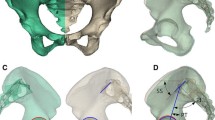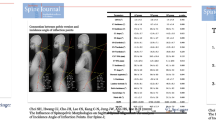Abstract
Introduction
Normal spino-pelvic values for patients with lumbarization of S1 have not been described in the literature. Presented are the normal values for this population group, the prevalence of S1 lumbarization, and the correlation between pelvic incidence (PI) and lumbar lordosis (LL) in this group.
Methods
Two databases of asymptomatic patients were combined to identify 11 patients with the lumbarization of S1. The whole spine images were used to measure the true prevalence rate. Lumbar 3D EOS models were built to measure spino-pelvic parameters for the lumbarization group compared to the asymptomatic population. Seven patients appeared at first to have six lumbar vertebrae, but counting caudally from C2 showed this was not the case.
Results
11/268 patients demonstrated the lumbarization of S1 to give a true prevalence rate of 4.1 %. The lumbarization group demonstrated a statistically significant difference with regard to PI, PT, and SS, and total lordosis measured from superior endplate of L1 to the superior endplate of the first fixed sacral segment. L6I was not significantly correlated to lordosis; however, PI did have a significant correlation with lordosis. Lordosis could be estimated in this group by the equation: \( {\text{LL }} = 1.16 \times {\text{PI}} - 19.39 \).
Conclusion
Incomplete imaging of the spine may lead to false estimation of the prevalence of lumbarization. Patients with lumbarization have higher lordosis values and lordosis can now be estimated during pre-operative planning for this group.




Similar content being viewed by others
References
Ucar D, Ucar BY, Cosar Y, Emrem K, Gumussuyu G, Mutlu S, Mutlu B, Cacan MA, Mertsoy Y, Gumus H (2013) Retrospective cohort study of the prevalence of lumbosacral transitional vertebra in a wide and well-represented population. Arthritis 2013:461425
Apazidis A, Ricart PA, Diefenbach CM, Spivak JM (2011) The prevalence of transitional vertebrae in the lumbar spine. Spine J 11(9):858–862
Castellvi AE, Goldstein LA, Chan DP (1984) Lumbosacral transitional vertebrae and their relationship with lumbar extradural defects. Spine 9(5):493–495
French HD, Somasundaram AJ, Schaefer NR, Laherty RW (2014) Lumbosacral transitional vertebrae and its prevalence in the Australian population. Glob Spine J 4(4):229–232
Nakajima A, Usui A, Hosokai Y, Kawasumi Y, Abiko K, Funayama M, Saito H (2014) The prevalence of morphological changes in the thoracolumbar spine on whole-spine computed tomographic images. Insights Imaging 5(1):77–83
Tokgoz N, Ucar M, Erdogan AB, Kilic K, Ozcan C (2014) Are spinal or paraspinal anatomic markers helpful for vertebral numbering and diagnosing lumbosacral transitional vertebrae? Korean J Radiol 15(2):258–266
Hahn PY, Strobel JJ, Hahn FJ (1992) Verification of lumbosacral segments on MR images: identification of transitional vertebrae. Radiology 182(2):580–581
Peh WC, Siu TH, Chan JH (1999) Determining the lumbar vertebral segments on magnetic resonance imaging. Spine 24(17):1852–1855
Paik NC, Lim CS, Jang HS (2013) Numeric and morphological verification of lumbosacral segments in 8280 consecutive patients. Spine 38(10):E573–E578
Boulay C, Tardieu C, Hecquet J, Benaim C, Mouilleseaux B, Marty C, Prat-Pradal D, Legaye J, Duval-Beaupere G, Pelissier J (2006) Sagittal alignment of spine and pelvis regulated by pelvic incidence: standard values and prediction of lordosis. Eur Spine J 15(4):415–422
Legaye J, Duval-Beaupere G, Hecquet J, Marty C (1998) Pelvic incidence: a fundamental pelvic parameter for three-dimensional regulation of spinal sagittal curves. Eur Spine J 7(2):99–103
Roussouly P, Gollogly S, Berthonnaud E, Dimnet J (2005) Classification of the normal variation in the sagittal alignment of the human lumbar spine and pelvis in the standing position. Spine 30(3):346–353
Kumar MN, Baklanov A, Chopin D (2001) Correlation between sagittal plane changes and adjacent segment degeneration following lumbar spine fusion. Eur Spine J 10(4):314–319
Dominguez D, Faundez A, Demezon H, Cogniet A, Le Huec JC (2016) Normative values for the L5 incidence in a subgroup of transitional anomalies extracted from 147 asymptomatic subjects. Eur Spine J. doi:10.1007/s00586-015-4371-6
Roussouly P, Gollogly S, Berthonnaud E, Dimnet J (2005) Classification of the normal variation in the sagittal alignment of the human lumbar spine and pelvis in the standing position. Spine 30(3):346–353
Farshad M, Aichmair A, Hughes AP, Herzog RJ, Farshad-Amacker NA (2013) A reliable measurement for identifying a lumbosacral transitional vertebra with a solid bony bridge on a single-slice midsagittal MRI or plain lateral radiograph. Bone Joint J 95-B(11):1533–1537
Le Huec JC, Hazegawa K (2016) Normative values for the spine shape parameters using 3D standing analysis from a database of 268 asymptomatic Caucasian and Japanese subjects. Eur Spine J. doi:10.1007/s00586-016-4485-5
Santiago FR, Milena GL, Herrera RO, Romero PA, Plazas PG (2001) Morphometry of the lower lumbar vertebrae in patients with and without low back pain. Eur Spine J 10(3):228–233
Silov G, Erdogan Z, Ozdal A, Ozaslamaci A (2015) Bone single-photon emission computed tomography and three-dimensional computed tomography in the diagnosis of low costal variation and pathologies. Indian J Nucl Med 30(2):183–184
Malanga GA, Cooke PM (2004) Segmental anomaly leading to wrong level disc surgery in cauda equina syndrome. Pain Phys 7(1):107–110
Author information
Authors and Affiliations
Corresponding author
Ethics declarations
Conflict of interest
None of the authors has any potential conflict of interest.
Additional information
The study was approved by the local ethic committee: Number ID-RCB 2010-A01248-31.
Rights and permissions
About this article
Cite this article
Price, R., Okamoto, M., Le Huec, J. et al. Normative spino-pelvic parameters in patients with the lumbarization of S1 compared to a normal asymptomatic population. Eur Spine J 25, 3694–3698 (2016). https://doi.org/10.1007/s00586-016-4794-8
Received:
Revised:
Accepted:
Published:
Issue Date:
DOI: https://doi.org/10.1007/s00586-016-4794-8




